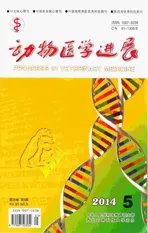国外猪弓形虫感染的风险因素及基因型研究进展
2014-03-23尹志奎
尹志奎,王 东,郑 斌*
(1.新乡医学院药理学教研室,河南新乡453003;2.新乡医学院寄生虫学教研室,河南新乡453003)
弓形虫(Toxoplasma gondii)为世界性分布的专性细胞内寄生原虫,可主动入侵多种哺乳动物(猪、牛、羊等)和人的细胞,导致弓形虫感染或弓形虫病(Toxoplasmosis)。猪感染弓形虫后不仅影响其自身的发育、繁殖,对养殖业发展造成一定的经济损失,若以感染猪来源的肉制品作为食物,还可能威胁到其他动物和人的健康。研究发现猪的弓形虫感染与某些因素相关联,不同地区的猪弓形虫感染的影响因素不同。弓形虫有3个主要基因型,即Ⅰ、Ⅱ和Ⅲ型,在全球广泛分布。基因分析发现不同地区的弓形虫分离株在遗传上有不同的多样性,基因型的不同导致虫体的致病力及对药物的敏感性存在差异。对弓形虫的基因型进行分析,可以为弓形虫病的诊断和治疗提供依据[1-2]。下面对国外的猪弓形虫感染的风险因素及基因型的研究进展进行综述,以期对后续动物的饲养及弓形虫病的治疗提供参考。
1 猪弓形虫感染检测及基因型分析方法
用于检测猪弓形虫感染的方法主要有血清学和分子生物学方法。血清学方法包括乳胶凝集试验(LAT)、改良凝集试验(MAT)、直接凝集试验(DAT)、间接血凝试验(IHA)、酶联免疫吸附试验(ELISA)和间接荧光抗体试验(IFAT)等。分子生物学方法包括聚合酶链反应(PCR)和脱氧核糖核酸(DNA)探针技术等。不同检测方法的敏感性和特异性不同,采用不同检测方法得到的结果不具可比性。弓形虫基因型分析方法有限制性片段长度多态性PCR(PCR-RFLP)、多重PCR(multiplex PCR)、套式PCR(nested PCR)和PCR-DNA 测序法等,不同的研究选用的遗传标记可能不同。
2 猪弓形虫感染的风险因素
泰国南部小猪弓形虫血清阳性率为71.43%(LAT),同时还检测到农场的一只猫的血清弓形虫抗体为阳性。推测该农场猪弓形虫感染途径为经胎盘垂直传播及猫粪中的弓形虫卵囊污染猪的食物和饮用水等[3]。芬兰野猪场野猪弓形虫血清阳性率为33.0%(DAT),雌性、2岁以上及小猪群的猪弓形虫阳性率较高[4]。2007年检测荷兰猪弓形虫抗体阳性率 为2.6% (ELISA),其中散养猪的阳性率(33%)明显高于农场猪(4%);2008年报道荷兰3个猪场猪弓形虫血清阳性率为8% ~17%(ELISA),经过为期4个月的捕鼠运动后,弓形虫血清阳性率下降至0~10%,提示控制鼠类可以降低猪的弓形虫感染;Opsteegh M 等[5]研究发现荷兰的野猪弓形虫抗体阳性率为24.4%(ELISA),随年龄的增加而增高。拉脱维亚(Latvia)野猪弓形虫抗体阳性率(33.2%)明显高于家猪(4.2%,ELISA),散养猪的阳性率(6.2%)明显高于猪场饲养的猪(0.4%),接触野生动物和外界环境的猪弓形虫阳性率明显高于其他猪[6]。2004年报道德国Hesse地区母猪弓形虫抗体阳性率为19%(ELISA &IFAT),阳性率与年龄相关。法国Corsica岛野猪肉汁弓形虫血清阳性率为0.55%(MAT),与野猪年龄和生长地区相关[7];Beral M 等[8]报道法国野猪弓形虫血清阳性率为23%(MAT),与野猫存在及气温相关。瑞士家猪弓形虫抗体阳性率为23.3%(ELISA),随年龄增加而增高,且高于10年前的阳性率[9]。意大利西西里岛猪弓形虫抗体阳性率为16.3%(ELISA),与猪年龄、养殖场规模(<50头)、饮用水安全及鼠类的控制等相关[10];Veronesi F等[11]报道意大利猪弓形虫IgG 阳性率为16.14%(IFAT),与猪饲养条件及环境卫生相关。葡萄牙北部猪弓形虫血清阳性率为9.8%(MAT),与年龄相关[12]。2005年报道西班牙野猪弓形虫血清阳性率为38.4%(MAT),南方地区野猪阳性率较高;西班牙东北部猪弓形虫血清阳性率为19.0%(MAT),影响因素有猪年龄、断奶期病死率、猫的出现和猪场的户外设施等[13];García-Bocanegra I等[14]报道西班牙猪弓形虫血清阳性率为16.6%(MAT),与猪年龄、鼠类控制及猫的出现等相关。罗马尼亚家猪弓形虫抗体阳性率为23.1%(IFAT),野猪阳性率为16%,与猪饲养环境相关[15]。
美国猪弓形虫抗体阳性率为2.6%(ELISA),与鼠类控制和动物尸体的处理方式等相关[16];美国北卡罗来纳州野猪弓形虫IgG阳性率为27.7%(MAT),与猪的年龄相关[17]。墨西哥Durango州猪弓形虫血清阳性率为12.7%(MAT),本地猪的阳性率(16.0%)高于外地猪(9.1%),杂种猪阳性率(15.7%)高于纯种猪(10.3%),阳性率与猪的年龄、猪场管理及猪场所处的地理位置等相关[18];美国Oaxaca州家猪弓形虫血清阳性率为17.2%(MAT),阳性率与猪的年龄、性别、猪场地理位置、气候和海拔高度等相关[19]。
巴西Toledo 地区的猪弓形虫血清阳性率为13.4%(MAT),与猪的食物及饮用水的卫生、鼠类的控制及断奶小猪的体重等相关[20];该国Rio de Janeiro州北部猪弓形虫抗体阳性率为11.5%(ELISA),散养猪阳性率为20.6%,而室内饲养猪无一例阳性,阳性率与猪饲养环境相关[21]。2004年报道阿根廷母猪弓形虫抗体阳性率为37.8%(MAT),室内农场猪弓形虫阳性率为4.5%,而同期检测室外农场的猪阳性率则高达40.5%,猪弓形虫感染与饲养环境相关。
3 猪弓形虫感染的基因型
日本Okinawa地区猪弓形虫检出率为56.4%(PCR),分离得到49个虫株,RFLP分析(遗传标记:SAG2)揭示其中22株弓形虫基因型为Ⅰ型,23株为Ⅱ型,4株为Ⅲ型[22];该地区另一批猪的弓形虫DNA 检出率为36.3%(PCR),分离得到29个弓形虫株,套式PCR,RFLP分析(遗传标记:GRA6),其中13株弓形虫基因型为Ⅰ型,14株为Ⅱ型,其余2株为Ⅲ型[23]。
葡萄牙猪弓形虫血清阳性率为15.6%(MAT),接种、分离得到15 个分离株,PCR-RFLP(遗传标记:SAG2)分析揭示其中11株基因型为Ⅱ型,其余4株为Ⅲ型[24]。法国野猪弓形虫血清阳性率为17.6%(MAT),接种、分离得到21株弓形虫,PCR-RFLP(遗传标记:SAG1、SAG2 和GRA7)揭示弓形虫基因型为Ⅱ型[25]。
2008年Dubey等检测美国马里兰猪弓形虫抗体阳性率分别为25%(ELISA)和71%(MAT),接种、分离得到14 个弓形虫株,PCR-RFLP(遗传标记:SAG1、SAG2、SAG3、BTUB、GRA6、c22-8、c29-2、L358、PK1和Apico)分析发现其中10株基因型为Ⅱ型,3株为Ⅲ型,1株为Ⅳ型;2012年检测美国北部猪弓形虫血清阳性率为 91%(ELISA&MAT),PCR-RFLP分析(遗传标记:SAG1、SAG2、SAG3、BTUB、GRA6、c22-8、c29-2、L358、PK1 和Apico)揭示弓形虫基因型为Ⅱ、Ⅲ型[26]。2007年报道巴西Erechim 地区猪弓形虫DNA 检出率分别为34%(猪舌)和66%(膈肌)(PCR),RFLP分析(遗传标记:SAG2、BTUB、SAG3和GRA6)揭示弓形虫基因型大部分为Ⅰ型,少部分为Ⅲ或Ⅱ/Ⅲ重组型;Bezerra R A等[27]报道巴西东北部地区猪弓形虫基因型为TgPgBr 06、08、11、12、14和15等6个新型(PCR-RFLP,遗传标记:SAG1、SAG2、SAG3、BTUB、C22-8、PK1 和Apico)。
4 结语
猪是弓形虫感染和传播的重要宿主。猪年龄、性别、饲养条件、外界环境中猫、鼠类的存在等等多种因素都可影响猪的弓形虫感染。日本、葡萄牙、法国和美国北部猪感染弓形虫的基因型为全球广泛分布的典型的Ⅰ、Ⅱ、Ⅲ型,巴西东北部猪弓形虫基因型为6个新型。各地的猪弓形虫感染的基因型的研究结果印证了南美洲动物感染的弓形虫基因型的遗传多态性共识。关于国内动物弓形虫感染的基因型的研究始于2007年,国内猪弓形虫感染的基因型研究揭示多数分离株的基因型为ToxoDB#9 型,少数为ToxoDB#213 型、ToxoDB#204 型或ToxoDB#205型。ToxoDB#9型为中国动物的优势基因型,又称Chinese Ⅰ型[28-29]。不同地区猪感染弓形虫的风险因素、基因型各不相同,不同基因型弓形虫致病性及药物敏感性不同。因此,各地区应根据当地实际情况制定相应的养殖及动物疾病检疫措施,做好猪弓形虫感染检测及预防工作,加强对病猪肉管理和处理,以减少食品公共卫生安全隐患,降低动物和人弓形虫感染和弓形虫病的发生。
[1]Ajzenberg D,CognéN,Paris L,et al.Genotype of 86Toxoplasma gondiiisolates associated with human congenital toxoplasmosis,and correlation with clinical findings[J].J Infect Dis,2002,186(5):684-689.
[2]Meneceur P,Bouldouyre M A,Aubert D,et al.In vitrosusceptibility of various genotypic strains ofToxoplasma gondiito pyrimethamine,sulfadiazine,and atovaquone[J].Antim A-gent Chem,2008,52(4):1269-1277.
[3]Thiptara A,Kongkaew W,Bilmad U,et al.Toxoplasmosis in piglets[J].Ann N Y Acad Sci,2006,1081:336-338.
[4]Jokelainen P,Näreaho A,Hälli O,et al.Farmed wild boars exposed toToxoplasma gondiiandTrichinellaspp[J].Vet Parasitol,2012,187(1-2):323-327.
[5]Opsteegh M,Swart A,Fonville M,et al.Age-relatedToxoplasma gondiiseroprevalence in Dutch wild boar inconsistent with lifelong persistence of antibodies[J].PLoS One,2011,6(1):e16240.
[6]Deksne G,Kirjušina M.Seroprevalence ofToxoplasma gondiiin domestic pigs(Sus scrofa domestica)and wild boars(Sus scrofa)in Latvia[J].J Parasitol,2013,99(1):44-47.
[7]Richomme C,Afonso E,Tolon V,et al.Seroprevalence and factors associated withToxoplasma gondiiinfection in wild boar(Sus scrofa)in a Mediterranean island[J].Epidemiol Infect,2010,138(9):1257-1266.
[8]Beral M,Rossi S,Aubert D,et al.Environmental factors associated with the seroprevalence ofToxoplasma gondiiin wild boars(Sus scrofa),France[J].Ecohealth,2012,9(3):303-309.
[9]Berger-Schoch A E,Bernet D,Doherr M G,et al.Toxoplasma gondiiin Switzerland:a serosurvey based on meat juice analysis of slaughtered pigs,wild boar,sheep and cattle[J].Zoonoses Public Health,2011,58(7):472-478.
[10]Villari S,Vesco G,Petersen E,et al.Risk factors for toxoplasmosis in pigs bred in Sicily,Southern Italy[J].Vet Parasitol,2009,161(1-2):1-8.
[11]Veronesi F,Ranucci D,Branciari R,et al.Seroprevalence and risk factors forToxoplasma gondiiinfection on finishing swine reared in the Umbria region,central Italy[J].Zoonoses Public Health,2011,58(3):178-184.
[12]Lopes A P,Dubey J P,Neto F,et al.Seroprevalence ofToxoplasma gondiiinfection in cattle,sheep,goats and pigs from the North of Portugal for human consumption[J].Vet Parasitol,2013,193(1-3):266-269.
[13]García-Bocanegra I,Dubey J P,Simon-GriféM,et al.Seroprevalence and risk factors associated withToxoplasma gondiiinfection in pig farms from Catalonia,north-eastern Spain[J].Res Vet Sci,2010,89(1):85-87.
[14]García-Bocanegra I,Simon-GriféM,Dubey J P,et al.Seroprevalence and risk factors associated withToxoplasma gondiiin domestic pigs from Spain[J].Parasitol Int,2010,59(3):421-426.
[15]Paŝtiu AI,Gyōrke A,Blaga R,et al.In Romania,exposure toToxoplasma gondiioccurs twice as often in swine raised for familial consumption as in hunted wild boar,but occurs rarely,if ever,among fattening pigs raised in confinement[J].Parasitol Res,2013,112(6):2403-2407.
[16]Hill DE,Haley C,Wagner B,et al.Seroprevalence of and risk factors forToxoplasma gondiiin the US swine herd using sera collected during the National Animal Health Monitoring Survey(Swine 2006)[J].Zoonoses Public Health,2010,57(1):53-59.
[17]Sandfoss M,De Perno C,Patton S,et al.Prevalence of antibody toToxoplasma gondiiandTrichinellaspp.in feral pigs(Sus scrofa)of eastern North Carolina[J].J Wildl Dis.2011,47(2):338-343.
[18]Alvarado-Esquivel C,García-Machado C,Alvarado-Esquivel D,et al.Seroprevalence ofToxoplasma gondiiinfection in domestic pigs in Durango State,Mexico[J].J Parasitol.2011,97(4):616-619.
[19]Alvarado-Esquivel C,Estrada-Malacón M A,Reyes-Hernández S O,et al.High prevalence ofToxoplasma gondiiantibodies in domestic pigs in Oaxaca State,Mexico[J].J Parasitol,2012,98(6):1248-1250.
[20]Piassa F R,de Araújo J B,da Rosa R C,et al.Prevalence and risk factors forToxoplasma gondiiinfection in certified and non-certified pig breeding farms in the Toledo microregion,PR,Brazil[J].Rev Bras Parasitol Vet,2010,19(3):152-156.
[21]Frazǎo-Teixeira E,de Oliveira F C.Anti-Toxoplasma gondiiantibodies in cattle and pigs in a highly endemic area for human toxoplasmosis in Brazil[J].J Parasitol,2011,97(1):44-47.
[22]Zakimi S,Kyan H,Oshiro M,et al.PCR-based discrimination ofToxoplasma gondiifrom pigs at an abattoir in Okinawa,Japan[J].J Vet Med Sci,2006,68(4):401-404.
[23]Zakimi S,Kyan H,Oshiro M,et al.Genetic characterization of GRA6genes fromToxoplasma gondiifrom pigs in Okinawa,Japan[J].J Vet Med Sci,2006,68(10):1105-1107.
[24]de Sousa S,Ajzenberg D,Canada N,et al.Biologic and molecular characterization ofToxoplasma gondiiisolates from pigs from Portugal[J].Vet Parasitol,2006,135(2):133-136.
[25]Richomme C,Aubert D,Gilot-Fromont E,et al.Genetic characterization ofToxoplasma gondiifrom wild boar(Sus scrofa)in France[J].Vet Parasitol,2009,164(2-4):296-300.
[26]Dubey J P,Hill D E,Rozeboom D W,et al.High prevalence and genotypes ofToxoplasma gondiiisolated from organic pigs in northern USA[J].Vet Parasitol,2012,188(1-2):14-18.
[27]Bezerra R A,Carvalho F S,Guimarǎes L A,et al.Genetic characterization ofToxoplasma gondiiisolates from pigs intended for human consumption in Brazil[J].Vet Parasitol,2012,189(2-4):153-161.
[28]Zhou P,Sun X T,Yin C C,et al.Genetic characterization ofToxoplasma gondiiisolates from pigs in southwestern China[J].J Parasitol,2011,97(6):1193-1195.
[29]Wang L,Chen H,Liu D,et al.Genotypes and mouse virulence ofToxoplasma gondiiisolates from animals and humans in China[J].PLoS One,2013,8(1):e53483.
